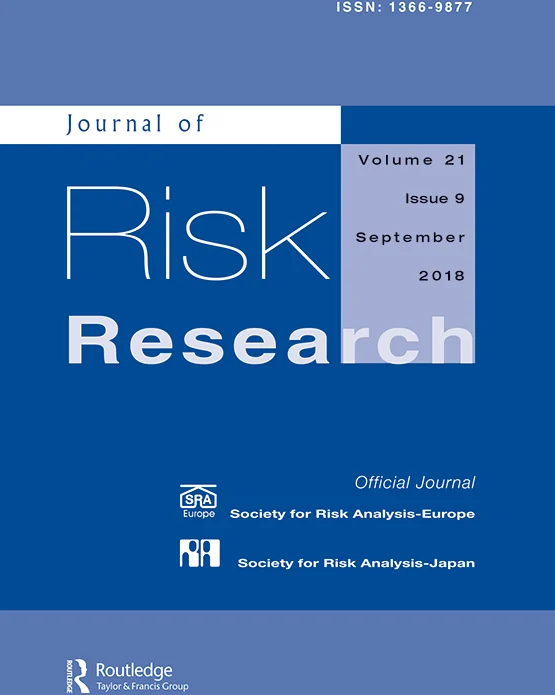对风险通报采取参与性办法:污染物与因纽特人健康的案例
IF 2.4
4区 管理学
Q1 SOCIAL SCIENCES, INTERDISCIPLINARY
引用次数: 0
摘要
摘要居住在北极的土著居民通常依靠乡村食品来获得营养、精神和文化利益。然而,一些食物来源已被重金属或持久性有机污染物污染。由于这些污染物,风险传播者必须就食用乡村食品的风险和益处制定有效且符合文化的健康信息。为了应对努纳维克加拿大因纽特人地区的这一挑战,成立了一个工作组,以推进风险管理,确定健康建议,并传达有关当地国家食品的建议。努纳维克儿童发展研究(NCDS)传播工作组包括当地猎人、教育工作者、医疗保健专业人员、研究人员和传播者等。完成了对NCDS沟通工作组成员的深入访谈,以深入了解风险管理方法以及沟通信息和材料是如何制定和交付的。研究结果表明,将受风险影响的因纽特人纳入传播材料设计和传播的重要性。此外,研究人员和医疗保健专业人员能够:(1)获得重要的当地知识;(2) 更好地了解民众的看法;以及(3)评估导致污染物暴露的行为。通过纳入多种观点并将受影响地区的人口纳入决策过程,在风险管理和沟通设计方面达成了更大的共识。我们讨论了利用包括参与元素的方法的好处和挑战,以及从这个案例中吸取的教训如何有助于更广泛地参与风险沟通文献。这项研究最终深入了解了如何使用参与式风险管理和沟通方法的要素——考虑不同的经验、知识和技能——可以产生潜在的更具文化相关性的健康咨询和风险沟通活动。本文章由计算机程序翻译,如有差异,请以英文原文为准。
Towards a participatory approach to risk communication: the case of contaminants and Inuit health
Abstract Indigenous populations residing in the Arctic commonly rely on country foods for nutritional, spiritual and cultural benefits. However, some food sources have become contaminated with heavy metals or persistent organic pollutants. As a result of these contaminants, it is critical that risk communicators develop effective and culturally appropriate health messages about the risks and benefits of eating country foods. To address this challenge in the Canadian Inuit region of Nunavik, a working group was formed to advance risk management, determine health advisories, and communicate recommendations about local country foods. The Nunavik Child Development Study (NCDS) Communications Working Group included local hunters, educators, health care professionals, researchers, and communicators, among others. In-depth interviews with members of the NCDS Communications Working Group were completed to provide insight into the risk management approach and how communication messages and materials were developed and delivered. Study results reveal the importance of including members of the Inuit population affected by the risk in the design and dissemination of communication material. In addition, researchers and healthcare professionals were able to: (1) access important local knowledge; (2) better understand the perceptions of the populations; and (3) assess behaviors that contributed to contaminant exposure. By incorporating multiple perspectives and including members of the population in the affected region in the decision-making process, there was greater consensus in risk management and communication design. We discuss the benefits and challenges of utilizing an approach that includes participatory elements, and how lessons from this case can contribute to participatory risk communication literature more broadly. This study ultimately provides insight into how using elements of a participatory approaches to risk management and communication – that considers different experiences, knowledges, and skills – can result in potentially more culturally relevant health advisories and risk communication campaigns.
求助全文
通过发布文献求助,成功后即可免费获取论文全文。
去求助
来源期刊

Journal of Risk Research
SOCIAL SCIENCES, INTERDISCIPLINARY-
CiteScore
12.20
自引率
5.90%
发文量
44
期刊介绍:
The Journal of Risk Research is an international journal that publishes peer-reviewed theoretical and empirical research articles within the risk field from the areas of social, physical and health sciences and engineering, as well as articles related to decision making, regulation and policy issues in all disciplines. Articles will be published in English. The main aims of the Journal of Risk Research are to stimulate intellectual debate, to promote better risk management practices and to contribute to the development of risk management methodologies. Journal of Risk Research is the official journal of the Society for Risk Analysis Europe and the Society for Risk Analysis Japan.
 求助内容:
求助内容: 应助结果提醒方式:
应助结果提醒方式:


